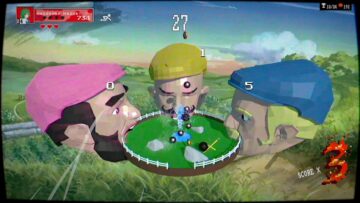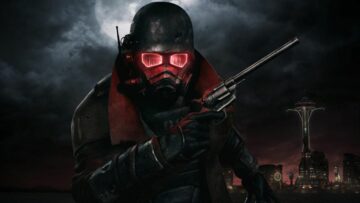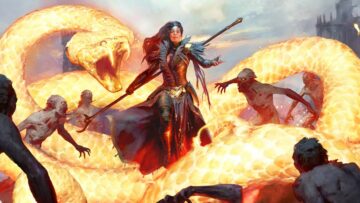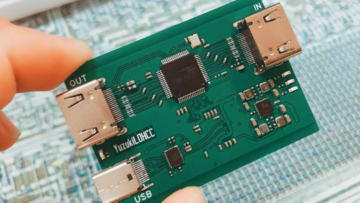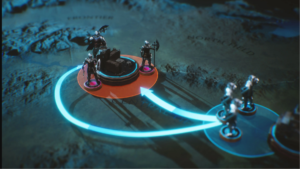What is it? A novel Strategy JRPG.
Expect to pay: £15.49/$20
Release date: Out now
Developer: Dancing Dragon Games
Publisher: Freedom Games
Reviewed on: AMD Radeon RX 6800 XT, 32GB RAM, AMD Ryzen 9 5900
Multiplayer? No
There’s a simple delight to JRPG character customization. Extend that to an entire squad of characters on a tactical grid? Now you’ve got your classic Strategy JRPG, like Fire Emblem or Final Fantasy Tactics. Extend it to an entire army of several dozen squads? That’s the rework you get in Symphony of War: The Nephilim Saga. Setting out a buffet of customization around your army and its generals is just enough to shake up a genre that was quickly becoming one-note—even if the otherwise generic story does it no favors.
Symphony of War’s spin on the strategy JRPG is all about the squad. Each squad is made up of as many as nine units, each placed into a formation that you create on 15 squares—and the boundaries between them—for about 15 distinct positions. Whereas other games emphasize single individuals, only the most powerful heroes can take on an enemy squad single-handed in Symphony. Instead of customizing the precise stats of individual people, you decide the squad built around them, tweaking composition and class as you go, and pushing their leadership stat ever-higher to increase their max squad size. Equipment also goes to the squad, with powerful artifacts taking up both limited equipment slots and space that could be used for soldiers.

But despite all that complexity, it’s surprisingly easy to grasp. There’s a decent in-game reference manual, and while some in-depth mechanics and the precise effect of stats—or how some terrain works—aren’t very clear, it never feels like you’re held back by a lack of understanding.
#SquadGoals
All that core gameplay serves to make your army and its journey, rather than any single character in it, the focus of your attention. In building your squads and shaping an overall strategy for your army, Symphony of War feels like a genuinely new angle on the genre, with the only comparable games being the Ogre Battle series—all now well over 20 years old.
Recruiting promising rookies and mercenaries off the market, fitting them into a squad, fiddling with their stats as they level up, and pushing them further up the large tree of connected classes is a satisfying core loop, with plenty of strategy knobs to tweak and levers to pull. It’s also structured in a way that encourages you to explore, letting you freely drop characters back a class tier to try something new without any penalty.
Take Stefan, the roguish hero, for example. He’s a natural leader for a light infantry squad, but could also lend his ambush expertise to a squad of light cavalry. The Knight hero Barnabas is a pretty good tank, but he’s also got traits that make his squadmates get better at leadership themselves: His squad is a perfect incubator to make promising candidates into future squad leaders.

Some leaders are more specialized: General Lysander gets a discount on the space gunpowder units take up in his squad. He’s a great leader for dragoon cavalry or a pike-and-shot tercio. These are leadership traits that exist not just in your pre-made heroes, but in unique named mercenaries that pop up in shops between missions, and even sometimes from skill-giving tomes dropped out in the world.
All that customization is constrained by the gold you earn in missions and arena battles, which has to be spent on the market to get new units and artifacts. (You’ll want to save some, too, in case you encounter rare Bazaars mid-mission—they’ve got the best stuff of all. Like dragon whelps. Always buy those.) Increasingly specialized units also need increasingly specialized resources, which you have to buy from markets and retrieve from mines and villages during missions: Gemstones to make mages, horses for cavalry, iron for infantry, and rarer resources—sunstones, obsidian—the further up the class tree you get.
Apocalypse Again
There’s not a dearth of world to explore, either. There are 30 core missions, a handful of side quests, an arena system to fight in for rewards, and a forthcoming endless training mode. There’s a melodramatically over-the-top story tied to it all, too: your classic semi-apocalyptic end of the world and attendant divinely-chosen savior stuff. Your main heroes talk and form familial or romantic bonds between missions, showing off a bit of personality, though that feature is very anemic compared to other games. Don’t expect a fully-fledged dating sim ala modern Fire Emblem here, just a tree of conversations to click through at your leisure.

The story is nothing too complex or adult, but not so bad that it distracts from the fun of actually playing. This is, to be pointed, not a genre that many players come to for fine characterization and poignant storytelling and for all the mechanical innovation you won’t find it here either. The loop is to manage the army, read some story, fight, read a bit more, and manage your army again.
That’s not always perfectly executed. Sometimes the story steps in, taking away units for a few missions or limiting which forces you can bring to bear—which is done well here, but is a pet peeve for many. There’s also a notable failure to blend story and mechanics in a few parts by employing similar strategy game tropes. Stuff like employing boring objectives during a forced loss mission, or forcing you to play out extremely one-sided missions where you can’t lose.
It’s all carried off in bright, cheerful pixel art in battles, and more muted static character portraits during dialogue. The pixel art is actually especially nice, and really packs a lot of character and energy into pretty small spaces. Over it all is a cheery soundtrack, and though it’s a bit thin, the tracks it does have are quite good—they capture the mood well.
Turning tactical
But what you’re here for is the tactics, and that is where Symphony of War: The Nephilim Saga shines. Having built an army from what you can and can’t afford, using what commanders you have, you now have to take it into the field. Each mission has a squad deployment limit, generally ranging from 5 to the late-game total of 20. On the field you’ve got objectives to capture, challenges to attempt, and resources to pillage from mines. Sticking to a tight turn limit, eliminating key enemies, and completing those bonus objectives lets you raise your faction rank—more on that later.

This is on the face of it really simple grid-based combat. One square vertical or horizontal is one move, no diagonals, and each squad moves in a way determined by its majority composition. A squad of mostly light infantry can ignore terrain penalties and attack from cover for an ambush bonus, while cavalry can inflict morale-shattering Shock with a charge in open terrain, and while heavy infantry have neither benefit, they do give bonus defense to units behind them on the squad layout grid…
Oh, sorry, we’re talking about squad building again, aren’t we? It can’t be helped. These two parts of Symphony are so thoroughly and delightfully linked.
When your squad attacks an enemy’s on the battlefield map, we jump to close-up combat for two alternating rounds of attacks: Attacker first, then defender. Attacks like ambushes deprive your enemy of their first round of attacks. The attacks of most mages take time to charge up, so they don’t do anything on the first round but lay out a powerful blast on the second. Gunpowder units fire on the first round, but can’t fire again on the second. In short, it’s an autobattle where your melee units attack the enemy in front of them on the grid and ranged units pick a target of opportunity while specialist units like healers, dragons, thieves, and mages do their thing in turn.
Battlefields of note
Broader tactical choices play into the fights, mostly revolving around terrain, unit type, and morale. You might strike from a hill to increase your range, keep to the woods to provide cover from archers, or stick in the open to avoid ambushing enemy light squads. I was a big fan of using tough units of knights out in the open, just two spaces away from a forest or hill, then when enemies put themselves between my knights and the terrain catching them in an ambush by the light squad attacking from the woods. I had to watch the morale of those knights, of course, because a surrounded unit’s low morale causes it to take more damage, while high morale can sometimes give units bonus attacks.

There are beyond basic fights specific tactical choices you can gain access to: Styles of attack like aggression to deal more damage but take more, or targeting the enemy leader to damage their morale. They’re all interesting choices, the bread and butter of strategy games, but the most interesting of these opens up a few missions in, and enables you to attempt to force the enemy to surrender.
Enemies with low morale, while outmatched, can be given this option. If they take it they’re immediately wiped off the field regardless of HP, and you get bonus faction rank and gold after the mission. If they don’t take it you’re caught out, they attack first, and you lose a round of the subsequent combat. It’s an absolutely superb bit of not just mechanical, but storytelling flavor: You’re the good guys, you fight mercifully, and you’re rewarded mechanically for that.

Between missions you do all the squad building and management, but you also build up your army in other ways. Faction experience stars let you unlock new technologies, which can be as banal as increasing morale damage for killing the enemy leader and as revolutionary as allowing gunpowder units to fire twice in one combat, or unlocking new units like dragon riders. If you’re like me you’ll easily spend as much time tweaking, planning, and optimizing your army as actually fighting with it.
Which is superb. The heart of this genre is enjoying the subtle interactions between game mechanics, customizing your characters, and tweaking their equipment list. It doesn’t matter much if the story’s not the best when I thought, halfway through the game, that I’d explore some set of build options next time through. I hadn’t even finished and I knew I’d play it again.

